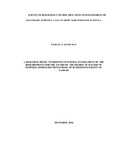| dc.description.abstract | This study was a survey of budgetary control practices in management of secondary schools in Meru North region in Kenya. The theory of budgeting, accounting, budgetary control theory and the school based budgeting model were reviewed under the theoretical framework. Determinants of budgetary control were examined after which an empirical review of the study variables was done both globally and locally. A descriptive survey design was adopted to capture the categorical description of population attitudes. Sample size of the study consisted of 160 secondary schools in Meru North Region. The sample size constituted 75 secondary schools in Meru North Region. Out of the selected schools, convenience sampling was used to select 2 respondents from the schools to make a total sample size of the respondents to be 150. Both open and closed semi-structured questionnaires were used for data collection. Secondary data sources were used to supplement the data collected from questionnaires. Validity and reliability were determined. Data was analysed to establish the measures of central tendency that include the mean, mode, and median highlighting the key findings. Inferential statistics was used to establish the relationship between the variables of the study and qualitatively by content analysis. Analysis of variance (ANOVA) was used to determine the significance relationship of the variables. Regression analysis was used to determine the extent to which budgetary control affects management of educational institutions in Meru North District in Kenya. The study established positive relationship between management of secondary institutions and budgetary control practices by the schools. In establishing the time period covered by budgets, the study found that majority (65.15%) of schools in Meru north region review budget after 1 to 5 years. Pertaining the annual budget revenue, it was found that 55.07% of the secondary schools in Meru north region have approximate budget revenue of Ksh.1,200,000 - 3,600,000 per annum while the study found that none of the school budget holders‟ disagreed that there were no objectives in the budget while results are linked to programs and school activities. On the impact of evaluation on budgetary control practices in management of secondary schools, the study found schools involves all key players in decisions about budget and the management of the schools review the budget as the respondents strongly agreed at 44% respectively. The study recommended frequent budget review as soon as possible, further recommended capacity building courses for schools BoM members through the ministry of education in Kenya, both internal and external evaluations be done regularly to ensure school finances are prudently utilized as per the school‟s education objectives while nomination of BoMs members prioritize those versed with financial management concepts and demonstrate highest integrity. A study is recommended to evaluate the adoption of common technology software and advanced accounting systems in the management of finances in secondary schools. Further studies are emphasized on the effect of education level for board members (currently Board of management) on implementation of development plans and their appointment procedure, effect of involvement of deputy principals in the budgeting committee, on development plan, effects of gender of principals on implementation of school development plans and the influence of auditing and reporting on implementation of development plan. | en_US |



